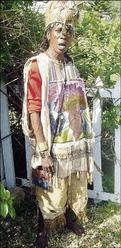Paul H. Williams, Gleaner Writer

Gloria Simms - photos by Paul Williams
When you see her, there is no doubt in your mind that this statuesque woman is proud of herself and of her African heritage. What else could she be when she goes around in clothes and adornments that many 'modern' Jamaicans would not be caught dead in.
Her clothes and headpieces, as do her outlook on life and her involvement in the revival of the Trelawny Town Maroon community in St James, are saying loud and clear that Cultural Ambassador Gloria 'Mama G' Simms is a woman on a mission to preserve her culture.
Born in Wakefield, Trelawny, she is the direct descendant of many generations of the Trelawny Town Maroons of St James; her childhood was very different from her peers.
"As a child, I could foresee things, so I was very reserved at first, very afraid because of the culture of obeah. I thought I was going to be an obeah woman ... and it was very strange for me," she recalled.
Wide awake, she would see events unfolding before her eyes, and see people whom she had never met before, and would then see them in person, a day or two later. It was frightening, so much so, that she spent much time away from everybody to meditate on what was happening to her.
Spiritual journey
From Trelawny, she moved to St Thomas, then to Kingston to live and work. It was also a spiritual journey, trying to find her place and purpose in this unfolding universe. After much soul-searching, she embraced Rastafarianism, which is a way of life for her. And so are her efforts to keep her Maroon heritage alive.
In Flagstaff, St James, which is a part of the old Trelawny Town, she is a spiritual leader. In such a role, she is a chieftess who "guide the people, preserve the culture, promote it, develop it ... who you would say is a representative of the culture, transmitting it back in an exemplary way". Thus, her efforts in helping to revive the long and colourful history of Trelawny Town.
Dormant
For, while the Scotts Hall, Charles Town, Moore Town and Accompong Town Maroon communities are steeped in preserving the culture of their ancestors, the Trelawny Town heritage has been dormant for quite a while, covered with the nuances of 21st century lifestyle. With the involvement of other stakeholders, Priestess Gloria wishes to see the village rise to the prominence that it deserves in the annals of Jamaican history.
"It's a rich town, it has nine historical sites of the actual fights with the British. It has a very rich history ... I have been carrying the message. I keep it on the lips and on minds of people. We are setting up so that we can have researchers and development workers ... We want this place to be a cultural mecca."
But why resurrect and/or keep traditions that some might regard as alien and irrelevant to modern-day sensibilities?
"In times like these, we have lost our cultural identity ... most of the things that are happening around us is because of the loss of cultural identity ... everybody is trying to adopt other cultures, lose their identity and cause a lot of anti-social behavioural problems," Mama G explained.
She has therefore rejected many of the trappings, lifestyle and diet of modern Western society, going around without shoes and dresses in traditional outfits which she designed herself.
The love of Africa
She said: "Clothes are a statement ... it is how I identity myself. People have to look and see something different sometimes, and then they take stock. It is the love of Africa, the love of the indigenous things around me, which I use."
Also integral to her spiritual outpouring is traditional dancing. It includes Kumina trance dancing, reggae, nyahbinghi, and just about anything of traditional form. She regards dancing as one of the highest forms of worship.
"It's a way of liberation, healing, very therapeutic. It's a way of reaching out into the cosmic."
So, reaching out seems to be the essence of the existence of the mother of three and grandmother of three, who is also a trained social worker, and volunteer. To her, the solution to the poor attitude towards cultural preservation is reparation of the mentality of the people. And one way of accomplishing such is by placing emphasis on the arts.
She reasoned: "It is holistic. It is not just for economics. It is also for developing the mind, the healing of the mind. The arts can be used in every way, so that people can be aware of who they are and the value they carry."
paul.williams@gleanerjm.com

